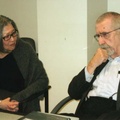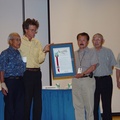Read Part 7 >>
Creating Alien Enemies
Edward Ennis’ Deputy in the DOJ Alien Enemy Control Unit, John Burling, was the designated hearing officer for the renunciation hearings at Tule Lake. Burling said that the renunciation hearings would be a careful, deliberate process, making it difficult to renounce. Instead, the DOJ set up what amounted to a deportation mill, stripping Americans of their citizenship and providing the government with a legal fig-leaf that justified the individual detentions. Burling even recommended “accepting these applications on the spot, and holding the required interview at the same time.” In a December 23, 1944 memo, Burling wrote:
“It is my belief that the motive impelling these persons to renounce their nationality is a deep feeling of hurt not only as a result of the evacuation which they…consider to be a denial of their constitutional rights but also as a result of the entire picture of racial discrimination. Renunciation of nationality in these cases is not in truth an affirmation of loyalty to Japan but the injured response of an American boy or girl to the broken promise of the first self-evident truth of the Declaration of Independence.”
Yet, despite his perceptive understanding of what drove so many to give up their citizenship, Burling showed no compassion toward the victims of the Department’s token hearing process. “It is my view that the particular group even of Americanized Nisei have gone so far in the expressions of disloyalty that it would not be desirable to find that these particular renunciations of nationality are contrary to the interests of national defense. I, therefore, recommend that all of the renunciations of nationality obtained by me and annexed hereto be approved by the Attorney General.”1
In late December 1944, a team under the general supervision of Mr. Burling arrived at Tule Lake to take applications and provide perfunctory “kangaroo court” hearings. For two and one-half months that ended on March 17, 1945, the Attorney General accepted applications from 5,461 people imprisoned at the Tule Lake Segregation Center who sought to renounce their citizenship. Seven out of every ten citizens age eighteen and above gave up their citizenship, and 73% of families had at least one renunciant.2
Ultimately, 5,725 American-born citizens of Japanese ancestry 18 and older formally applied to renounce their American citizenship prior to V-J day, and the Attorney General accepted all 5,725.3 Only 128 persons from places other than Tule Lake renounced.4 Contrary to a belief of the DOJ, a significant number of the American citizens who had renounced their U.S. citizenship did not hold dual citizenship. After renouncing, they became stateless “Native American Aliens.”5
President Harry S. Truman authorized deportation on July 14, 1945, in Proclamation Number 2655, under the authority of the Alien Enemy Act of 1798. This was a needed step toward the legal expulsion of unwanted Japanese Americans. The Proclamation was requested by the Attorney General; it stated that during declared wartime those persons deemed dangerous to the public peace and safety of the United States “shall be subject upon the order of the Attorney General to removal from the United States and may be required to depart therefrom.”6 Now, those who renounced could be legally detained and then expelled.
During July, August, and September 1945, in the Segregation Center and the DOJ prisons, renunciants grew frantic over possible deportations to Japan, writing thousands of letters to DOJ and other agencies pleading to them to void or reverse the renunciations. All requests were refused. Instead, the Department of Justice prepared for mass deportations.7
The Legal Struggle to Restore Citizenship
Wayne Mortimer Collins was born in 1900 in Sacramento and educated in San Francisco. He is best remembered as an ardent fighter for Japanese American civil rights. Collins was a fierce advocate for those incarcerated in strife-torn Tule Lake, and was instrumental in closing the infamous stockade, the jail within the concentration camp that was a constant reminder to inmates of the consequences of civil disobedience.
Collins’ best-known case was Korematsu v. United States, in the landmark appeal to the Supreme Court to test the constitutionality of the mass removal and detention of Japanese Americans. Another of his well-known cases was that of Iva Ikuko Toguri D’Aquino, wrongly convicted of treason as “Tokyo Rose,” who eventually received a Presidential pardon. He also represented 365 Japanese Peruvians who were kidnapped from their homes in Latin American and held like chattel in American internment camps until the U.S. prepared to deport them to a war-torn and defeated Japan.
On the dedication page of Years of Infamy, Michi Weglyn described Collins as one “Who Did More to Correct a Democracy’s Mistake Than Any Other One Person.” The mistake Weglyn refers to was the DOJ renunciation and denationalization program. The lawsuits to restore their U.S. citizenship remained in the courts for 23 years, and Wayne Collins was the key figure in this prolonged struggle.
On November 13, 1945, only two days before a ship prepared to sail filled with 4,700 Japanese Americans being deported to Japan, Collins stopped the deportations until the matter could be heard before a judge.8 At the same time Collins filed Abo v. Clark and Furuya v. Clark that sought to cancel the renunciations, charging that the renunciation program relied on manipulation and intimidation of Japanese Americans by government agents. In mute testimony to the trauma, confusion, and misunderstanding surrounding the renunciations, nearly all who renounced—5,409 American-born Nisei, including many of the 1,327 people who were expatriated to Japan—sought restoration of their U.S. citizenship.
On April 12, 1949, Judge Goodman entered a final decree, cancelling the plaintiff’s renunciations and declaring their renunciations void ab initio, thus restoring the plaintiffs’ status as citizens of the United States. Goodman’s opinion attributed the renunciations to governmental duress, and found that the government erred in accepting the renunciations.9 “It is shocking to the conscience that an American citizen be confined without authority and then, while so under duress and restraint, for his Government to accept from him a surrender of his constitutional heritage.”10
In a letter analyzing potential actions the Department of Justice could take in response to Judge Goodman’s decision to cancel the renunciations, Edward Ennis, the architect of the renunciation program who was now in private practice, stated, “The Government was embarrassed by the probable unconstitutionality of the detention of thousands of American citizens of Japanese ancestry.” He acknowledged that, “If we had to do the thing over, with the facts we now know, we probably would not seek the renunciation statute but would continue the questionable detention which at least would not have such lasting results.”11 Of the three options he outlined, the one Ennis urged on the Department of Justice is this:
Accept Judge Goodman’s decision, take no appeal, and allow the renunciations to be cancelled. Where, as here, there is a very good chance that the Supreme Court would affirm Judge Goodman’s decision, the Solicitor General would certainly be justified in determining that no appeal should be taken. In view of the opinions in the Endo case it is most likely that a majority of the Supreme Court, willing to permit the evacuation but not subsequent detention, would be disposed to wipe out the renunciations as an unwarranted permanent result of the wartime evacuation in which the Court reluctantly acquiesced. The Department might wisely conclude the whole matter by sharing the responsibility with Judge Goodman and by the Solicitor General determining that no appeal should be taken.12
However, the DOJ was unwilling to leave on the books a finding that the renunciations resulted from duress created by government actions, and appealed Goodman’s decision. A year later, the Ninth Circuit ruled that Goodman erred in consolidating the cases.
Notes:
1. RG 60 DOJ File 146-54-012 Sections 1-3. December 23, 1944 Memo from office of Edward Ennis, Director Alien Enemy Control Unit, DOJ, to Herbert Wechsler.
2. Donald E. Collins, page 101.
3. Supplemental Report, page 116
4. Supplemental Report, page 116.
5. Donald E. Collins, page
6. Donald E. Collins, page 110.
7. Donald E. Collins, page 111. Unpublished “Statement of the Tule Lake Defense Committee” (n.d.), page 2, personal files of Wayne M. Collins, San Francisco.
8. Weglyn, pages 255-56.
9. Donald E. Collins, page 131.
10. Opinion of U.S. District Judge Goodman filed in Abo v. Clark and Furuya v. Clark, page 14. Filed April 29, 1948. 77 F. Supp. 806. The language paraphrases that used in the Tule Lake draft resister case that Goodman decided, U.S. v. Kuwabara, 56 Fed. Supp. 716 decided July 22, 1944 that he describes as a “curtain raiser” to the Abo and Furuya cases, page 7.
11. RG 60, Acc. No. 70-A-3747, DOJ file no. 146-54-012, Section 2. Letter from Edward Ennis, Attorney at Law, former Director of the Alien Enemy Unit, DOJ to H. Graham Morison, Assistant Attorney General, Department of Justice, July 27, 1948.
12. 108. RG 60, Acc. No. 70-A-3747, DOJ file no. 146-54-012, Section 2.
Letter from Edward Ennis, Attorney at Law, former Director of the Alien Enemy Unit, DOJ to H. Graham Morison, Assistant Attorney General, Department of Justice, July 27, 1948. The second alternative Ennis offered; to select a few test cases and final orders obtained then appealed to the Supreme Court, dragging the whole problem into the Supreme Court with small chance that the Government would win. The third alternative, to litigate each case and appeal all adverse decisions, which would entail enormous amounts of work and require appeals to be perfected in all the cases to obtain final authoritative decisions.
* This article was originally published in the Journal of the Shaw Historical Library, Vol. 19, 2005, Klamath Falls, OR.
* * *
* Barbara Takei will be a presenter for “The Tule Lake Segregation Center: Its History and Significance” session at JANM’s National Conference, Speaking Up! Democracy, Justice, Dignity on July 4-7, 2013 in Seattle, Washington. For more information about the conference, including how to register, visit janm.org/conference2013.
© 2005 Barbara Takei







